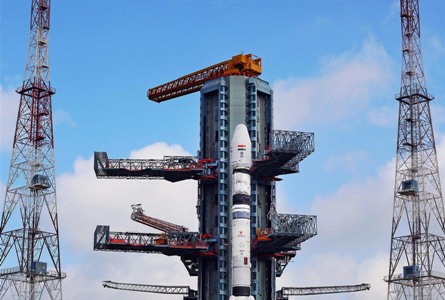
Geo-synchronous Satellite Launch Vehicle (GSLV) D6 carrying GSAT-6, lifts off from Satish Dhawan Space Centre in Sriharikota, Andhra Pradesh on Thursday. Photo: PTI/ISRO
SRIHARIKOTA, AP (PTI): India on Thursday successfully launched its latest communication satellite GSAT-6, having an indigenous cryogenic engine, onboard the GSLV-D6 rocket from the spaceport here.
The feat is the second one for the Indian Space Research Organisation scientists in using the indigenously made cryogenic stage after the January 5, 2014 launch of GSLV-D5.
The earlier one had propelled India into an elite group of countries boasting of the homegrown complex cryogenic engine and stage after twin failures in 2010.
Describing the successful launch as a "Onam gift", Mission Director R Umamaheswaran said the 'naughty boy' (cryogenic stage) has now been transformed into the 'most adored boy of the ISRO'.
"ISRO has offered an Onam gift... a reliable launch vehicle with our own Made in India cryogenic stage... which can launch 2-2.5 tonne class satellites," he said.
"We have demonstrated what happened in January 2014 was no fluke, it was a result of tremendous effort put in by the entire team for the indigenous cryogenic stage... various intricacies of cryogenic have been understood," a jubilant ISRO Chairman A S Kiran Kumar said.
In a precise text book launch, GSLV-D6 carrying the 2117 kg GSAT-6 lifted off at 4.52 pm from the second launch pad of the Satish Dhawan Space Centre here and placed the satellite in orbit, after about 17 minutes.
ISRO is the sixth space agency in the world after those of US, Russia, Japan, China and France to have joined the indigenous cryogenic regime, which is crucial for launch of heavier satellites weighing more than two tonnes.
Prime Minister Narendra Modi congratulated the ISRO team, terming the launch as a "phenomenal accomplishment".
"Another day & another phenomenal accomplishment by our scientists. Congratulations @isro for the successful launch of GSAT-6" he tweeted.
Referring to previous GSLV-D5 developmental flight with the indigenous cryogenic stage, Umamaheswaran said, "The onus was on us to maintain the standard set by the previous launch.
This mission has achieved equally well orbit."
"On February 5, the naughty boy was tamed... now it has been transformed into the most adored boy of ISRO and that has been made possible by the awesome and fantastic team effort of all of you team ISRO," he said.
GSAT-6 is the 25th geostationary communication satellite built by ISRO and the 12th in the GSAT series. The satellite is equipped with five spot beams in S-band and a national beam in C-band for strategic users.
The "cuboid" shaped satellite has a lift-off mass of 2,117 kg. The propellants weigh 1,132 kg and the dry mass of the satellite is 985 kg.
ISRO said one of the advanced features of the communication satellite is its S-Band Unfurlable Antenna of six metre diametre,
which is the largest satellite antenna realised by it.
The antenna is utilised for five spot beams over the Indian mainland and they exploit the frequency reuse scheme to increase frequency spectrum utilisation efficiency.
After the injection of the satellite in the Geosynchronous Transfer Orbit by GSLV-D6, ISRO's Master Control Facility has taken control of GSAT-6.
It would perform the initial orbit raising manoeuvres by repeatedly firing the Liquid Apogee Motor on-board the satellite before finally placing it in the circular Geostationary Orbit.
The deployment of antenna and three axis stabilisation of the satellite would also be performed in the days to come.
The mission life of the satellite is nine years.
 Previous Article
Previous Article Next Article
Next Article












The Indian Air Force, in its flight trials evaluation report submitted before the Defence Ministry l..
view articleAn insight into the Medium Multi-Role Combat Aircraft competition...
view articleSky enthusiasts can now spot the International Space Station (ISS) commanded by Indian-American astr..
view article